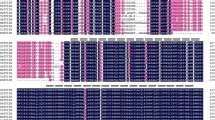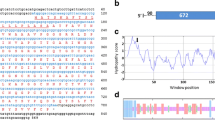Abstract
A novel pathogen-induced gene, designated CAPIP2, was isolated from pepper leaves infected with Xanthomonas campestris pv. vesicatoria. CAPIP2:GFP fusion proteins were primarily localized in the cytoplasm. The CAPIP2 transcripts were constitutively expressed in the pepper leaves, flowers, and fruits, but were not detected in the stems and roots. CAPIP2 gene expression was induced strongly in the pepper leaves during pathogen infection, and also after exposure to abiotic elicitors and environmental stresses. Ectopic CAPIP2 expression in Arabidopsis was accompanied by the expression of Arabidopsis PR-1 and PDF1.2 genes. Overexpression of the CAPIP2 gene in Arabidopsis transgenic plants conferred enhanced resistance to Pseudomonas syringae pv. tomato DC3000. The CAPIP2 transgenic Arabidopsis also manifested increased tolerance to high salt, drought and oxidative stress during seed germination and seedling state. These results suggest that pepper CAPIP2 gene may function as a defense-related gene against both biotic and abiotic stresses.
Similar content being viewed by others
References
Alvarez ME, Pennell RI, Meijer PJ, Ishikawa A, Dixon RA, Lamb C (1998) Reactive oxygen intermediates mediate a systemic signal network in the establishment of plant immunity. Cell 92:773–784
Bestwick CS, Brown IR, Bennett MHR, Mansfield JW (1997) Localization of hydrogen peroxide accumulation during the hypersensitive reaction of lettuce cells to Pseudomonas syringae pv. phaseolicola. Plant Cell 9:209–221
Bray EA (1997) Plant responses to water deficit. Trends Plant Sci 2:48–54
Chandra-Shekara AC, Navarre D, Kachroo A, Kang HG, Klessig D, Kachroo P (2004) Signaling requirements and role of salicylic acid in HRT- and rrt-mediated resistance to turnip crinkle virus in Arabidopsis. Plant J 40:647–659
Chomczynski P, Sacchi N (1987) Single-step method of RNA isolation by acid guanidium thiocyanate-phenol-chloroform extraction. Anal Biochem 162:156–159
Clough SJ, Bent AF (1998) Floral dip: a simplified method for Agrobacterium-mediated transformation of Arabidopsis thaliana. Plant J 16:735–743
Dangl JL, Dietrich RA, Richberg MH (1996) Death don’t have no mercy: cell death programs in plant–microbe interactions. Plant Cell 8:1793–1807
Dempsey DA, Shah J, Klessig D (1999) Salicylic acid and disease resistance in plants. Crit Rev Plant Sci 18:547–575
Desikan R, Reynolds A, Hancock JT, Neill SJ (1998) Harpin and hydrogen peroxide both initiate programmed cell death but have differential effects on defense gene expression in Arabidopsis suspension cultures. Biochem J 330:115–120
Devadas SK, Enyedi A, Raina R (2002) The Arabidopsis hrl1 mutation reveals novel overlapping roles for salicylic acid, jasmonic acid and ethylene signaling in cell death and defence against pathogens. Plant J 30:467–480
Dong X (1998) SA, JA, ethylene, and disease resistance in plants. Curr Opin Plant Biol 1:316–323
Gao AG, Hakimi SM, Mittanck CA, Wu Y, Woerner BM, Stark DM, Shah DM, Liang J, Rommens CM (2000) Fungal pathogen protection in potato by expression of a plant defensin peptide. Nat Biotechnol 18:1307–1310
Glazebrook J (2001) Genes controlling expression of defense responses in Arabidopsis-2001 status. Curr Opin Plant Biol 4:301–308
Hammond-Kosack KE, Jones JDG (1997) Plant disease resistance genes. Annu Rev Plant Physiol Plant Mol Biol 48:575–607
Hong JK, Hwang BK (2005) Functional characterization of PR-1 protein, β-1,3-glucanase and chitinase genes during defense response to biotic and abiotic stresses in Capsicum annuum. Plant Pathol J 21:195–206
Hong JK, Jung HW, Kim YJ, Hwang BK (2000) Pepper gene encoding a basic class II chitinase is inducible by pathogen and ethephon. Plant Sci 159:39–49
Ingram J, Bartels D (1996) The molecular basis of dehydration tolerance in plants. Annu Rev Plant Physiol Plant Mol Biol 47:377–403
Ishitani M, Xiong L, Lee H, Stevenson B, Zhu JK (1998) HOS1, a genetic locus involved in cold-responsive gene expression in Arabidopsis. Plant Cell 10:1151–1161
Jung HW, Hwang BK (2000) Isolation, partial sequencing, and expression of pathogenesis-related cDNA genes from pepper leaves infected by Xanthomonas campestris pv. vesicatoria. Mol Plant–Microbe Interact 13:136–142
Kasuga M, Liu Q, Miura S, Yamaguchi-Shinozaki K, Shinozaki K (1999) Improving plant drought, salt, and freezing tolerance by gene transfer of a single stress-inducible transcription factor. Nat Biotechnol 17:287–291
Kim YJ, Martin GB (2004) Molecular mechanisms involved in bacterial speck disease resistance of tomato. Plant Pathol J 20:7–12
Kim YJ, Hwang BK (2000) Pepper gene encoding a basic pathogenesis related 1 protein is pathogen and ethylene inducible. Physiol Plant 108:51–60
Lamb CJ, Lawton MA, Dixon RA (1989) Signal and transduction mechanisms for activation of plant defenses against microbial attack. Cell 56:215–224
Lee SC, Hwang BK (2003) Identification of the pepper SAR8.2 gene as a molecular marker for pathogen infection, abiotic elicitors and environmental stresses in Capsicum annuum. Planta 216:387–396
Lee SC, Hwang BK (2005) Induction of some defense-related genes and oxidative burst is required for the establishment of systemic acquired resistance in Capsicum annuum. Planta 221:790–800
Lee SC, Hwang BK (2006) CASAR82A, a pathogen-induced pepper SAR8.2, exhibits an antifungal activity and its overexpression enhances disease resistance and stress tolerance. Plant Mol Biol (In press)
Lee SC, Hong JK, Kim YJ, Hwang BK (2000) Pepper gene encoding thionin is differentially induced by pathogens, ethylene and methyl jasmonate. Physiol Mol Plant Pathol 56:207–216
Lee SC, Kim YJ, Hwang BK (2001) A pathogen-induced chitin-binding protein gene from pepper: its isolation and differential expression in pepper tissues treated with pathogens, ethephon, methyl jasmonate or wounding. Plant Cell Physiol 42:1321–1330
Lee YK, Hwang BK (1996) Differential induction and accumulation of β-1,3-glucanase and chitinase isoforms in the intercellular space and leaf tissues of pepper by Xanthomonas campestris pv. vesicatoria infection. J Phytopathol 144:79–87
Lichtenthaler HK (1987) Cholrophylls and carotenoids: pigments or photosynthetic biomembranes. Methods Enzymol 148:350–382
May MJ, Hammond-Kosack KE, Jones JDG (1996) Involvement of reactive oxygen species, glutathione metabolism and lipid peroxidation in the gene-dependent defense response of tomato cotyledons induced by race specific elicitors of Cladosporium fulvum. Plant Physiol 110:1367–1379
Mukhopadhyay A, Vij S, Tyagi AK (2004) Overexpression of a zinc-finger protein gene from rice confers tolerance to cold, dehydration, and salt stress in transgenic tobacco. Proc Natl Acad Sci USA 101:6309–6314
Oh S-K, Lee S-W, Kwon S, Choi D (2005) Development of a screening system for plant defense-inducing agent using transgenic tobacco plant with PR-1a promoter and GUS gene. Plant Pathol J 21:288–292
Park JM (2005) The hypersensitive response. A cell death during disease resistance. Plant Pathol J 21:99–101
Pastori GM, Foyer CH (2002) Common components networks, and pathways of cross-tolerance to stress. The central role of ‘redox’ and abscisic acid-mediated controls. Plant Physiol 129:460–468
Penninckx IAMA, Thomma BPHJ, Buchala A, Métraux J, Broekaert WF (1998) Concomitant activation of jasmonate and ethylene response pathways is required for induction of a plant defensin gene in Arabidopsis. Plant Cell 10:2103–2114
Piao HL, Lim JH, Kim SJ, Cheong GW, Hwang I (2001) Constitutive over-expression of AtGSK1 induces NaCl stress responses in the absence of NaCl stress and results in enhanced NaCl tolerance in Arabidopsis. Plant J 27:305–314
Rasmussen JB, Hammerschmidt R, Zook MN (1991) Systemic induction of salicylic acid accumulation in cucumber after inoculation with Pseudomonas syringae pv. syringae. Plant Physiol 97:1342–1347
Reymond R, Farmer EE (1998) Jasmonate and salicylate as global signals for defence gene expression. Curr Opin Plant Biol 1:404–411
Rickauer M, Brodschelm W, Bottin A, Veronesi C, Grimal H, Esquerre-Tugaye MT (1997) The jasmonate pathway is involved differentially in the regulation of different defense responses in tobacco cells. Planta 202:155–162
Ryals JA, Neuenschwander UH, Willits MG, Molina A, Steiner HY, Hunt MD (1996) Systemic acquired resistance. Plant Cell 8:1809–1819
Shen O, Li Q, He S-Y, Barker KR, Li D, Hunt AG (2000) Conversion of compatible plant-pathogen interactions into incompatible interactions by expression of the Pseudomonas syringae pv. syringae 61 hrmA gene in transgenic tobacco plants. Plant J 23:205–213
Shinozaki K, Yamaguchi-Shinozaki K (1997) Gene expression and signal transduction in water-stress response. Plant Physiol 115:327–334
Staehelin LA, Newcomb EH (2000) Membrane structure and membranous organelles. In: Buchanan B, Gruissem W, Jones RL (eds), Biochemistry and Molecular Biology of Plants, ASPP Press, Rockville, MD, pp 2–50
Surplus SC, Jordan BR, Murphy AB (1998) Ultraviolet-B-induced responses in Arabidopsis thaliana: role of salicylic acid and reactive oxygen species in the regulation of transcripts encoding photosynthetic acidic pathogenesis-related proteins. Plant Cell Environ 21:685–694
Thomma BPHJ, Eggermont K, Penninckx IAMA, Mauch-Mani B, Vogelassang R, Cammue BPA, Broekaert WF (1998) Separate jasmonate-dependent and salicylate-dependent defense-response pathways in Arabidopsis are essential for resistance to distinct pathogens. Proc Natl Acad Sci USA 95:15107–15111
Ukness S, Mauch-Mani B, Moyer M, Potter S, Williams S, Dincher S, Chandler D, Slusarenko A, Ward E, Ryals J (1992) Acquired resistance in Arabidopsis. Plant Cell 4:645–656
Van Loon LC, Pierpoint WS, Boller T, Conejero V (1994) Recommendations for naming plant pathogenesis-related proteins. Plant Mol Biol Report 12:245–264
Wang SM, Liu WL, Eimert K, Chen J (1996) Phytohormone-regulated beta-amylases gene expression in rice. Plant Mol Biol 31:975–982
Ward ER, Uknes SJ, Williams SC, Dincher SS, Wiederhold DL, Alexander DC, Ahl-Goy P, Metraux J, Ryals JA (1991) Coordinate gene activity in response to agents that induce systemic acquired resistance. Plant Cell 3:1085–1094
Yang Y, Shah J, Klessig DF. (1997) Signal perception and transduction in plant defense responses. Genes Dev 11:1621–1639
Zeevaart JAD, Creelman RA (1998) Metabolism and physiology of abscisic acid. Annu Rev Plant Physiol Plant Mol Biol 39:439–473
Zimmermann HM, Hartmann K, Schreiber L, Steudle E (2000) Chemical composition of apoplastic transport barriers in relation to radial hydraulic conductivity of corn root (Zea mays L.). Planta 210:302–311
Acknowledgements
This work was financially supported by a grant (CG1432) from the Crop Functional Genomics Center of the 21st Century Frontier Research Program, and also by a grant from the Center for Plant Molecular Genetics and Breeding Research, Seoul National University in Korea. We thank Michael Rabba for reading the manuscript.
Author information
Authors and Affiliations
Corresponding author
Rights and permissions
About this article
Cite this article
Lee, S.C., Kim, S.H., An, S.H. et al. Identification and functional expression of the pepper pathogen-induced gene, CAPIP2, involved in disease resistance and drought and salt stress tolerance. Plant Mol Biol 62, 151–164 (2006). https://doi.org/10.1007/s11103-006-9010-5
Received:
Accepted:
Published:
Issue Date:
DOI: https://doi.org/10.1007/s11103-006-9010-5




